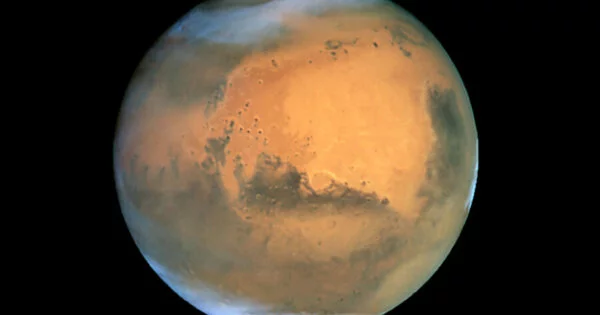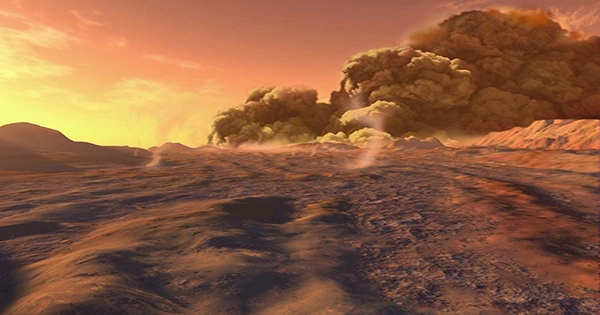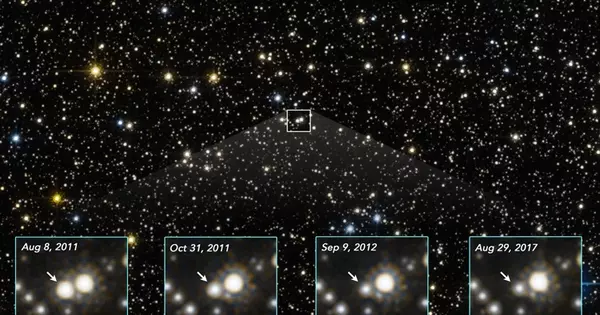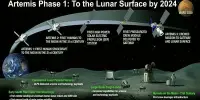The atmospheres of Earth and Mars are extremely dissimilar. While Earth’s atmosphere is rich in nitrogen and oxygen, that of Mars is almost entirely made up of carbon dioxide. Its atmosphere has a density that is less than one-fiftieth that of Earth’s, or roughly 35 km above the planet’s surface.
Their cloud patterns have been discovered to be very Earth-like yet very different, suggesting that they formed using the same principles.
Two dust storms that happened close to the martian North Pole in 2019 are examined in further detail in a new study. The storms were observed at the North Pole during spring when nearby storms frequently form around the melting ice cover.

The storms were photographed from orbit by the MARCI camera on board NASA’s Mars Reconnaissance Orbiter and the Visual Monitoring Camera (VMC) and High-Resolution Stereo Camera (HRSC) on board Mars Express.
The VMC image sequence demonstrates how the storms exhibit recurring cycles of growth and disappearance over the course of days. The broader views of the HRSC photos clearly show spiral structures. The spirals, which range in length from 1000 to 2000 km, share the same extratropical cyclone genesis as those seen in Earth’s mid-latitudes and polar regions.
Images show a specific Martian phenomenon. They demonstrate that the martian dust storms are composed of smaller cloud cells that are evenly spaced apart, and arrayed like grains or pebbles. Clouds in the atmosphere of Earth can also be seen to have a texture.
Convection, where hot air rises because it is less dense than the cooler air around it, creates recognizable textures. When air rises in the center of tiny cloud cells, this type of convection, known as closed-cell convection, is occurring. The pathways for cooler air to sink below the hot rising air are the spaces in the sky around the cloud cells.
On Earth, water is present in the rising air, which condenses to create clouds. The Mars Express’s images of dust clouds demonstrate the same phenomenon, but on Mars, the ascending air columns are made of dust rather than water. Dust-filled air is heated by the Sun, which causes it to ascend and form dust cells. Areas of sinking air that have less dust surround the cells. This results in the granular pattern that may be seen in images of clouds on Earth as well.
The wind speed can be determined by monitoring the movement of cells across the series of photographs. Up to 140 km/h of wind travels over the cloud features, stretching the form of the cells in the wind’s direction. Nature produces these regular patterns despite Mars’ and Earth’s dynamic and chaotic atmospheres.
“One could immediately picture an arid desert or a polar region when envisioning an atmosphere similar to Mars on Earth. It is therefore quite surprising that by following the erratic movement of dust storms, analogies can be drawn with the processes that take place in Earth’s moist, hot, and decidedly very different tropical regions, says Colin Wilson, the Mars Express project scientist for the European Space Agency.
The VMC photos have made it feasible to measure the altitude of dust clouds, which is a significant discovery. The height of the clouds above the martian surface is determined by measuring the length of the shadows they throw and combining that information with knowledge of the Sun’s position. The findings showed that dust can rise 6–11 km above the surface and that cells often had horizontal diameters of 20–40 km.
“We have seen that within their complexity, organized structures such as fronts and cellular convection patterns can emerge,” says Agustin Sánchez-Levaga from the Universidad del Pas Vasco UPV/EHU (Spain), who is the head of the VMC science team and the lead author of a paper presenting the new analysis. “This is despite the unpredictable behavior of dust storms on Mars and the strong wind gusts that accompany them.
These organized cellular convection patterns are not limited to the atmospheres of Earth and Mars; Venus Express observations of the Venusian atmosphere may also reveal similar patterns. “Our work on Mars dry convection is another illustration of the importance of comparative studies of similar phenomena occurring in planetary atmospheres to better understand the mechanisms underlying them under different conditions and environments,” continues Agustin.
Understanding dust storms is important for upcoming Mars missions as well as for knowing more about how planetary atmospheres “operate.” In extreme circumstances, dust storms may prevent a significant portion of sunlight from reaching rovers’ solar cells on the surface of Mars. A planetary-scale dust storm in 2018 not only prevented sunlight from reaching the surface but also covered the Opportunity rover’s solar panels in the dust. Due to the rover’s loss of electrical power caused by both of these factors, the mission was aborted.
Future solar-powered missions, and eventually crewed missions to the planet, must be protected against such potent phenomena, so tracking the development of dust storms is essential. The article “Cellular patterns and dry convection in textured dust storms at the edge of Mars North Polar Cap” was written by A. Sánchez-Lavega et al. and appeared in Icarus magazine on November 15, 2022.
















